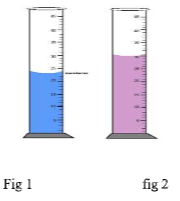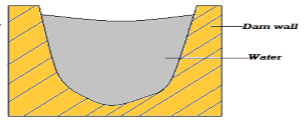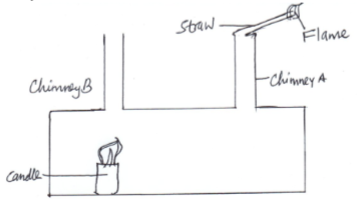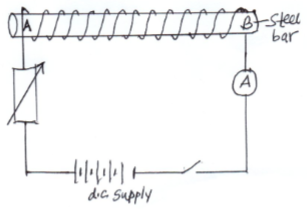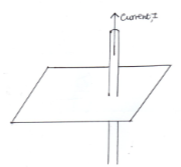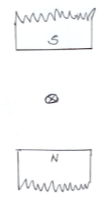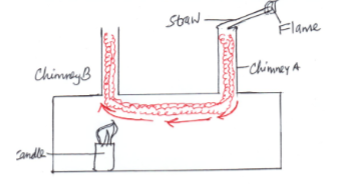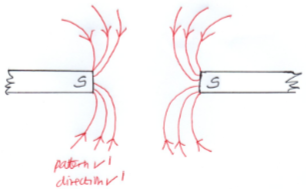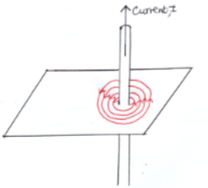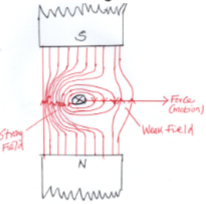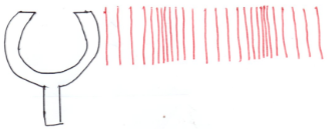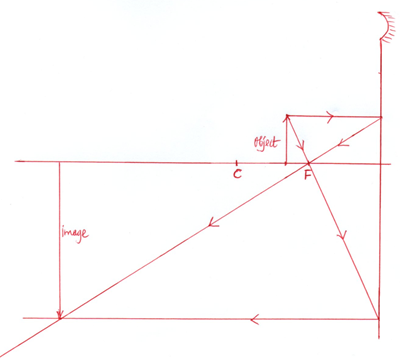INSTRUCTIONS TO CANDIDATES
- This paper consists of TWO sections: A and B
- Answer All questions in section A and B in the space provided.
- Show all the steps in your calculations, giving your answers at each stage in the spaces below each question.
Take: Acceleration due to gravity g = 10m/s2
Density of water 1 g/cm3
Density of mercury 13.6 g/cm3
SECTION A (40MARKS)
- Figure 1 below shows a measuring cylinder containing some water. A student added 200 drops of water into the measuring cylinder. The Fig 2 shows the measuring cylinder after the addition of the drops
- State.
- The volume of the water added. (2mks)
- Average volume of one drop of water. (2mks)
- State.
- State two ways of increasing the surface tension of a liquid (2 Marks)
- The figure below shows the transverse section of a water dam.
- Explain why engineers prefer this shape. (2 marks)
- Given that pressure at the deepest point is 400000N/m2 . Determine the depth of this point given that density of water is 1000kg/m3 . (3mks)
-
- Give a reason why the weight of a body on earth is greater than the weight of the same body on the moon. (2mks)
- An astronaut weighs 720N on the earth’s surface. On a certain planet he weighs 540N. Determine the gravitational acceleration on this planet. (Take g for earth = 10N/kg) (3mks)
-
- State two properties of a good thermometric liquid (2 marks)
- The figure below shows a clinical thermometer. State the purpose of the constriction. (1 mark)
- State Pascal’s principle of transmission of pressure in fluids. (1 mark)
- 1600cm3 of fresh water of density 1g/cm3 is mixed with 1400cm3 of sea water of density 1.25 g/cm3. Determine;
- The total mass of the mixture (2mks)
- The density of the mixture (2 marks)
- Name two types of forces which can act between objects which are not in contact. (2 marks)
- State the kinetic theory of gases (1mark)
- State one advantage of frictional force (1 mark)
- A stop watch started 0.5s after the start button was pressed. The time recorded using the stop watch for a ball falling through a liquid was 2.53s. Determine the time of fall. (1mk)
- State 2 properties of magnets.
- Explain why it is easier to loosen a nut using a spanner with a long handle than a spanner with a short handle. (2mks)
- State 2 ways in which the stability of a body can be increased. (2mks)
- State one advantage and one disadvantage of using a convex mirror as driving mirror. (2mks)
- A pipe of radius 6mm is connected to another pipe of radius 9mm . If water flows in the wider pipe at speed of 2m/s, what is the speed in the narrower pipe. (2mks)
- A spring stretches by 10mm when supporting a load of 4N. Determine how much it would stretch when supporting a load of 12N. (3mks)
SECTION B 60 MARKS
-
- What is anomalous expansion of water (1mk)
- Convert -123 c to temperature to kelvin (2mks)
- State the functions of the following features of a common thermometer
- Bulb (1mk)
- Capillary bore (1mk)
- Glass stem (1mk)
-
- Differentiate between temperature and heat (2mks)
- Why are liquids poor conductors of heat than solids (1mk)
- Define convection (1mk)
- A lighted candle is placed inside a transparent box with two chimneys and a smoldering straw on one chimney as shown
- State and indicate what is observed in the box (1mk)
- Explain your observation (2mks)
-
- State two properties of a magnet (2mks)
- State the basic law of magnetism (1mk)
- Define magnetic field (1mk)
- Draw the resultant, magnetic field pattern between two south poles below (2mks)
- The following diagram represent one method of making a magnet
- State the rule used to determine the poles of the attained magnet after the steel is magnetized.(1mk)
- Use the rule to determine the polarity of A and B. (1mk)
-
- The following diagram shows a current flowing in a straight conductor as shown. Draw the magnetic field pattern showing its direction (2mks)
-
- State one factor on which the magnetic strength of an electromagnet depends on showing how each factor relates to strength. (1mk)
- How does the factor you have stated above in b (i) affect the magnetic strength of an electromagnet (1mk)
- A straight current carrying conductor is placed between two poles of bar magnets as shown below.
- Draw the resultant field lines after interaction of the magnetic fields of the poles and those of the conductor. (2mks)
- Indicate the direction of the force acting on the conductor (1mk)
- The following diagram shows a current flowing in a straight conductor as shown. Draw the magnetic field pattern showing its direction (2mks)
-
- Define the following terms:
- Transverse waves (1mk)
- Longitudinal waves (1mk)
- A water wave travels 12m in 4s. If the frequency of the waves is 2Hz, calculate
- The speed of the wave (2mks)
- The wavelength of the wave (3mks)
- Define the following terms:
-
- The prongs of a tuning fork are made to vibrate by striking them against a hard surface and vibrate
- Draw the waves produced (2mks)
- Name the type of wave drawn (1mk)
- Draw the waves produced (2mks)
- State two factors which affect velocity of sound in air (2mks)
- Two boys stood 200m from a wall. One banged two pieces of wood together while the second one started a stop watch and stopped it when he heard the echo. If the time shown on the stop watch was 1.2 seconds. Calculate the speed of sound in air. (3mks)
- The prongs of a tuning fork are made to vibrate by striking them against a hard surface and vibrate
-
- A form 2 student used a vernier calipers to measure the diameter of a ball bearing. Determine the reading shown (2mks)
- An oil drop of diameter 0.5 mm spreads on the surface of water to form an oil patch of diameter 0.2m. Estimate the thickness of the oil patch.(3mks)
- A form 2 student used a vernier calipers to measure the diameter of a ball bearing. Determine the reading shown (2mks)
-
- Define the following terms as applied in curved mirrors
- The pole (1mk)
- Center of curvature (1mk)
- An object pin of height 2cm is placed 4cm in front of a concave mirror of focal length 3cm. construct a ray diagram by scale drawing to find the position of the image (3mks)
From your diagram, determine- The image distance (1mk)
- Magnification of the image (2mks)
- Define the following terms as applied in curved mirrors
-
- State the principle of moments (1mk)
- A uniform wooden bar, 100cm long balances at 70 cm mark when a mass of m kg is attached at 100cm mark as shown below.
If the mass of the wooden bar is 200 g, find the mass, m which balances the wooden bar (g = 10N/kg) (3mks)

MARKING SCHEME
SECTION A (40MARKS)
- Figure 1 below shows a measuring cylinder containing some water. A student allows 200 drops to fall into water in the measuring cylinder. Fig 2 shows the measuring cylinder after the addition of the drops
- State.
- The volume of the water added. (2mks)
V = (30-23)
V = 7cm3 - Average volume of one drop of water. (2mks)
V of one drop = 7/2OO
= 0.035cm3
- The volume of the water added. (2mks)
- State.
- State two ways of increasing the surface tension of a liquid (2 Marks)
- Lowering temperature of the liquid )
- Adding impurities
- The figure below shows the transverse section of a water dam.
- Explain why engineers prefer this shape to others (2 marks)
- Thicker walls at the bittom increases the strength of the walls ,thus they can withstand high pressure at the bottom due to water.
- Given that pressure at the deepest point is 400000N/m2. Determine the depth of this point given that desity of water is 1000kg/m3. (3mks)
P =hpg
400000 = h x 1000 x10
h = 40m
- Explain why engineers prefer this shape to others (2 marks)
-
- Give a reason why the weight of a body on earth is greater than the weight of the same body on the moon . (2mks)
W = mg
gearth is greater than gmoon - An astronaut weighs 720N on the earths surface. On a certain planet he weighs 540N. Determine the gravitational acceleration on this planet. ( Take g for earth = 10N/kg) (3mks)
W = mg
720 = m x 10
m =72kg
gplanet = 540/72
gp = 7.5N/kg
- Give a reason why the weight of a body on earth is greater than the weight of the same body on the moon . (2mks)
-
- State two properties of a good thermometric liquid (2 marks)
- good conductor of heat.
- visible
- expand and contract quickly and uniformly
- low freezing point and high boiling point
- should not stick on the sides tube
- The figure below shows a clinical thermometer. State the purpose of the constriction( 1 mark)
- Stop /prevents mercury from falling off/running back into the bulb before temp is read.
- State two properties of a good thermometric liquid (2 marks)
- State Pascal’s principle of transmission of pressure in fluids (1 mark)
- A fluid at rest in an enclosed container , a pressure change in one part is transmitted equally without loss to every part of the fluid and to the walls of the container.
- 1600cm3 of fresh water of density 1g/cm3 is mixed with 1400cm3 of sea water of density 1.25g/cm3.determine;
- The total mass of the mixture (2mks)
Total mass = mass of fresh water + mass of sea water.
= (1600 x1)g + (1400 x 1.25)
= 1600 + 1750
= 3350g - The density of the mixture (2 marks)
Density = mass/volume
= 3350/3000
= 1.117g/cm3
- The total mass of the mixture (2mks)
- Name two types of forces which can act between objects which are not in contact. (2 marks)
- magnetic
- electrostatic
- gravitational
- nuclear
- State the kinetic theory of gases (1mark)
- Matter is made up of very small particles which are in continuous state of motion.
- State one advantage of frictional force (1 mark)
- Enables walking.
- Breaks vehicles work due to friction.
- A stop watch started 0.5s after the start button was pressed. The time recorded using the stop watch for a ball falling through a liquid was 2.53s. Determine the time of fall. (1mk)
Time of fall = ( 2.53 + 0.5)
= 2.53s - State 2 properties of magnets.
- Directional properties.
- Polarity (magnetic poles) (2mks)
- Explain why it is easier to loosen a nut using a spanner with a long handle than a spanner with a short handle. (2mks)
- Long handle has a greater turning effect than a short handle.
- State 2 ways in which the stability of a body can be increased. (2mks)
- increasing the base area.
- Lowering the position of COG
- State one advantage and one disadvantage of using a convex mirror as driving mirror. (2mks)
- advantage …It has a wide view
- disadvantage ….gives diminished images ,giving an impression that vehicles behind are far yet they are near.
- A pipe of radius 6mm is connected to another pipe of radius 9mm . If water flows in the wider pipe at speed of 2m/s, what is the speed in the narrower pipe. (2mks)
A1 X V1 = A2 X V2
9 X 2 = 6 X V2
V2 = 3m/s - A spring stretches by 10mm when supporting a load of 4N. Determine how much it would stretch when supporting a load of 12N. (3mks)
F =ke
K = 4/10
=0.4N/mm
e = 12/0.4
= 30mm.
SECTION B
-
- What is anomalous expansion of water (1mk)
- Expansion of water as it is cooled from 4°C to 0°C
Or - Contraction of water as it is healed from 0°C to 4°C.
- Expansion of water as it is cooled from 4°C to 0°C
- Convert -123° c to temperature to kelvin (2mks)
T = ∅ +237
= −123 + 273 = 150K. - State the functions of the following features of a common thermometer
- Bulb (1mk)
- Effective heat transmission (between the liquid inside and the body whose Temperature is to be taken).
- Capillary bore (1mk)
- Carries the thermometric liquid and allows it expansion and contraction
- Glass stem (1mk)
- Serves as magnifying glass for easy reading of the scale.
- Bulb (1mk)
- What is anomalous expansion of water (1mk)
-
- differentiate between temperature and heat (2mks)
TEMPERATURE HEAT 1. Degree of coldness or hotness of a body 1. It’s a form of energy which passes from a body at a higher temperature to a body at a lower temperature 2. expressed in kelvin 2. expressed in joules - Why are liquids poor conductor s of heat than solids (1mk)
- Particles / molecules in a liquid are further apart from each other than they are in solids. Or there are larger inter molecular distances between liquids molecules than between solid particles.
- Define CONVECTION (1mk)
- Convection is the process by which heat is transferred through a fluids (liquids and gases)
- A lighted candle is placed inside a transparent box with two chimneys and a smoldering straw on one chimney as shown
- State and indicate what is observed in the box (1mk)
- Smoke is sucked into the box through chimney A and exits through chimney B.
- Explain your observation (2mks)
- The candle heats up the air above it, which expands and rises up because of lower density. Cold heavier air is drawn in through chimney A, carrying along the smoke which replaces the air that is escaping through chimney B.
- State and indicate what is observed in the box (1mk)
- differentiate between temperature and heat (2mks)
-
- state two properties of a magnet (2mks)
- The ends of a magnet have the greatest power of attraction
- A freely suspended bar magnet always settles in north – south direction
- State the basic law of magnetism (1mk)
- Like poles repel unlike poles attract
- Define magnetic field (1mk)
- It is the region/space where the magnetic influence is felt.
- Draw the resultant, the magnetic field pattern between two south poles below (2mks)
- The following diagram represent one method of making a magnet
- State the rule used to determine the poles of the attained magnet after the steel is magnetized.(1mk)
- Clock rule
- Use the rule to determine the polarity of A and B. (1mk)
- A north pole
- B South pole
- State the rule used to determine the poles of the attained magnet after the steel is magnetized.(1mk)
- state two properties of a magnet (2mks)
-
- The following diagram shows a current flowing in a straight conductor as shown. Draw the magnetic field pattern showing its direction (2mks)
-
- State one factors on which the magnetic strength of an electromagnet depends on showing how each factor relates to strength. (1mk)
- Current
- Number of turns per unit length of solenoids.
- Length of the solenoid
- Shape of the core {any 1}
- How does the factor you have stated above in b (i) affect the magnetic strength of an electromagnet (1mk)
- Increase in current increases strength
- Increase in number of turns per unit length of solenoid increases the strength
- The shorter the solenoid the greater the strength
- A core with a greater curvature has a greater strength
- State one factors on which the magnetic strength of an electromagnet depends on showing how each factor relates to strength. (1mk)
- A straight current carrying conductor is placed between two poles of bar magnets as shown below.
- Draw the resultant field lines after interaction of the magnetic fields of the poles and those of the conductor. (2mks)
- Indicate the direction of the force acting on the conductor (1mk)
- The following diagram shows a current flowing in a straight conductor as shown. Draw the magnetic field pattern showing its direction (2mks)
-
- Define the following terms:
- transverse waves (1mk)
- Are waves in which vibration of the particles are at right angles to the direction of the wave travel.
- Longitudinal waves (1mk)
- Are waves in which vibration of the particles is in a direction parallel to the direction of the wave travel.
- transverse waves (1mk)
- A water wave travels 12m in 4s. if the frequency of the waves is 2HZ, calculate
- The speed of the wave (2mks)
Speed = distance
time
= 12/4
= 3 m/s - The wavelength of the wave (3mks)
Speed = frequency x wavelength
V = fλ
3 = 2xλ
λ = 3/2
= 1.5 m
- The speed of the wave (2mks)
- Define the following terms:
-
- The prongs of a tuning fork are made to vibrate by striking them against a hard surface and vibrate
- Draw the waves produced (2mks)
- Name the type of wave drawn (1mk)
- Longitudinal
- Draw the waves produced (2mks)
- State two factors which affect velocity of sound in air (2mks)
- Temperature of the air
- Humidity of air
- Wind direction {any 2}
- Two boys stood 200m from a wall. One banged two pieces of wood together while the second one started a stop watch and stopped it when he heard the echo. If the time shown on the stop watch was 1.2 seconds. Calculate the speed of sound in air. (3mks)
Sound cavered 2x200m = 400m
Speed = distance = 400
time 1.2
= 333.33m/s
- The prongs of a tuning fork are made to vibrate by striking them against a hard surface and vibrate
-
- A form 2 student used a vernier calipers to measure the diameter of a ball bearing. Determine the reading shown (2mks)
Main scale = 2.1
Vernier scale 5 x 0.01 = 0.05 cm
2.15 - An oil drop of diameter 0.5 mm spreads on the surface of water to form an oil patch of diameter 0.2m. Estimate the thickness of the oil patch. (3mks)
Vol of spherical drop = vol of cylindrical patch
= 4/3 πr12 = πr22t
= 4/3 x 3.142 x (0.5/2)3 = 3.142 x (100)2t
= 4 x 0.015625 = 10000t
3
0.02083333 = 10000t
T= 0.02083333
10000
= 2.08 x 10-6 mm
- A form 2 student used a vernier calipers to measure the diameter of a ball bearing. Determine the reading shown (2mks)
-
- Define the following terms as applied in curved mirrors
- The pole (1mk)
- The pole is the centre of a curved mirror
- Center of curvature (1mk)
- Centre of curvature is the centre of the sphere of which the mirror is part
- The pole (1mk)
- An object pin of height 2cm is placed 4cm in front of a concave mirror of focal length 3cm. construct a ray diagram to find the position of the image (3mks)
From your diagram, determine- The image distance (1mk)
- 13.4 cm
- Magnification of the image (2mks)
M = v/u = 13.4/4 = 3.35
OR
M = hi/ho = 6.6/2 = 3.3
- The image distance (1mk)
- Define the following terms as applied in curved mirrors
-
- State the principle of moments (1mk)
- The principle of moments states that for a system in equilibrium, the sum of clockwise moments about a point is equal to the sum of anticlockwise moments about the same point
- A uniform wooden bar, 100cm long balances at 70 cm mark when a mass of m kg is attached at 100cm mark as shown below.
If the mass of the wooden bar is 200 g, find the mass, m which balances the wooden bar (g = 10N/kg) (3mks)
Weight of the bar acting at 50cm mark = mg = 200 x 10 =2N
1000
= 2 x 20 = (m x 10) x 30/100
100
40 = 300m
m = 40/300
= 0.1333 kg
- State the principle of moments (1mk)
Join our whatsapp group for latest updates
Tap Here to Download for 50/-
Get on WhatsApp for 50/-
Download Physics Questions and Answers - Form 3 Mid Term 1 Exams 2023.
Tap Here to Download for 50/-
Get on WhatsApp for 50/-
Why download?
- ✔ To read offline at any time.
- ✔ To Print at your convenience
- ✔ Share Easily with Friends / Students

